1890 · [Paris
by ARCHAMBAUT, Aline (1847-1908)
[Paris, 1890. Oblong folio (395 x 260 mm). 135 drawings of ornate furniture in lead and watercolor highlighted in gum arabic, on 104 leaves of heavy paper (later pencil foliation), including four mounted drawings on tinted paper and two smaller loose drawings, one of the latter signed A. Archambaut del., both with notes of measurements and pattern or stock numbers, the second with specifications of colors and material. No. 93, a bed, apparently unfinished. (Foxing and soiling to first and last leaves, occasional light foxing elsewhere, marginal soiling especially to first few leaves, fol. 104 detached, two drawings, on fols. 15 and 25 with small abraded areas, 5 other drawings with tiny abrasions or white flecks, the rest of the drawings in fine condition.) The drawings on guards, bound in half shagreen and pebble-grained cloth (rubbed), spine gilt lettered “Album Meubles Fantaisies.”***
A spectacular manuscript album of watercolor designs of colorfully decorated, painted and inlaid furniture, in Louis XV, Louis XVI, and Second Empire styles, by a female artist and furniture designer.
Depicted are commodes, large and small tables, desks, cabinets, wardrobes, sideboards, dressers, armchairs, mirrored stands, stands holding manicure sets, multi-drawered sécrétaires, beds, clocks, and even bellows and brooms for the chimney. Most are highly ornate and include colorful painted or inlaid decoration, meticulously rendered, often in minute detail, by the artist-designer. With their cabriole legs, serpentine curves, and lavish inlay and marquetry, these delightful creations express to a sometimes impractical degree the late 19th-century vogue for Louis XV and Louis XVI-style furniture.*
The artist can be identified as Aline Anne Archambault, née Carrausse, thanks to the one signed drawing, loosely inserted, which matches stylistically those of the album. The only child of the Paris furniture designer Jean Marie Carrausse, Archambault moved in artistic and artisanal circles: in 1877 she married Arthur Eugène Archambaut, a graveur ciseleur, or engraver of luxury metalwork; the four witnesses at their marriage were his uncle, a sculptor; his cousin, a printer; and two friends, identified respectively as a printer and a furniture maker (this information from Geneanet.org). The Victoria and Albert Museum holds six furniture drawings by her, also signed with her first initial and last name, and a few lithographs after her (one of the drawings, V&A accession number E.284-1952, has an additional printed signature, “P. Levant Carrausse del.,” clearly a member of her family). Since Aline was married and died in the 4th arrondissement in Paris, it is likely that this album was created there.
The title on the binding, “Album [of] Furniture Fantasies,” implies that at least some of the pieces were not intended to be built: they abound in bright colors and witty details, such as the tree-branches wrapping around two basket stands (fol. 17), or the wildly ornate bed with which the album ends. While the element of fantasy in these accomplished paintings is thus clear, many probably did function as specimens of furniture that could be ordered from members of the artist’s entourage of furniture makers. This is evident from the two inserted drawings, both of chests of drawers, which have measurement notes and stock numbers. One has the inkstamped name “G. Cauvet” on the verso.
The archival records indicate that Aline lost a daughter in infancy in 1877, when she was 30. She had no other children. The ebullient drawings in this album betray no hint of tragedy, and it is tempting to view them as a work of youth, before shadows arrived to dim the joy of creation.
* “The best known of the [nineteenth-century] revivals was that for Louis XV and Louis XVI furniture.... The Louis XV revival intensified during the Second Empire, when it departed so much from the 18th-c. prototype that it is best called `Rococo’.” (H. Osborne, ed., The Oxford Companion to the Decorative Arts (1988), p. 359) (Inventory #: 3212)
A spectacular manuscript album of watercolor designs of colorfully decorated, painted and inlaid furniture, in Louis XV, Louis XVI, and Second Empire styles, by a female artist and furniture designer.
Depicted are commodes, large and small tables, desks, cabinets, wardrobes, sideboards, dressers, armchairs, mirrored stands, stands holding manicure sets, multi-drawered sécrétaires, beds, clocks, and even bellows and brooms for the chimney. Most are highly ornate and include colorful painted or inlaid decoration, meticulously rendered, often in minute detail, by the artist-designer. With their cabriole legs, serpentine curves, and lavish inlay and marquetry, these delightful creations express to a sometimes impractical degree the late 19th-century vogue for Louis XV and Louis XVI-style furniture.*
The artist can be identified as Aline Anne Archambault, née Carrausse, thanks to the one signed drawing, loosely inserted, which matches stylistically those of the album. The only child of the Paris furniture designer Jean Marie Carrausse, Archambault moved in artistic and artisanal circles: in 1877 she married Arthur Eugène Archambaut, a graveur ciseleur, or engraver of luxury metalwork; the four witnesses at their marriage were his uncle, a sculptor; his cousin, a printer; and two friends, identified respectively as a printer and a furniture maker (this information from Geneanet.org). The Victoria and Albert Museum holds six furniture drawings by her, also signed with her first initial and last name, and a few lithographs after her (one of the drawings, V&A accession number E.284-1952, has an additional printed signature, “P. Levant Carrausse del.,” clearly a member of her family). Since Aline was married and died in the 4th arrondissement in Paris, it is likely that this album was created there.
The title on the binding, “Album [of] Furniture Fantasies,” implies that at least some of the pieces were not intended to be built: they abound in bright colors and witty details, such as the tree-branches wrapping around two basket stands (fol. 17), or the wildly ornate bed with which the album ends. While the element of fantasy in these accomplished paintings is thus clear, many probably did function as specimens of furniture that could be ordered from members of the artist’s entourage of furniture makers. This is evident from the two inserted drawings, both of chests of drawers, which have measurement notes and stock numbers. One has the inkstamped name “G. Cauvet” on the verso.
The archival records indicate that Aline lost a daughter in infancy in 1877, when she was 30. She had no other children. The ebullient drawings in this album betray no hint of tragedy, and it is tempting to view them as a work of youth, before shadows arrived to dim the joy of creation.
* “The best known of the [nineteenth-century] revivals was that for Louis XV and Louis XVI furniture.... The Louis XV revival intensified during the Second Empire, when it departed so much from the 18th-c. prototype that it is best called `Rococo’.” (H. Osborne, ed., The Oxford Companion to the Decorative Arts (1988), p. 359) (Inventory #: 3212)
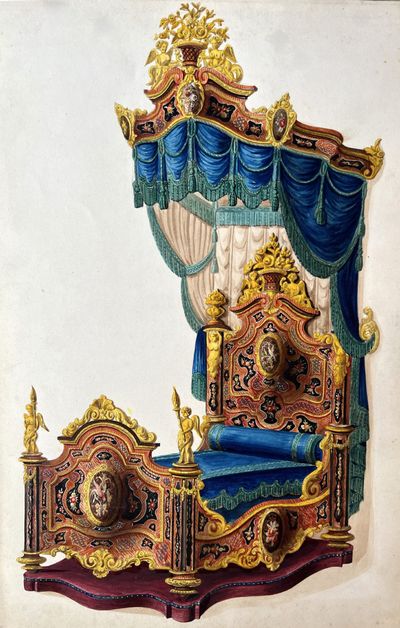
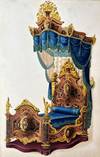
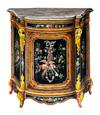
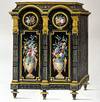

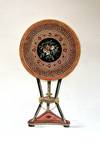




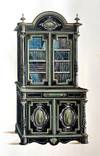
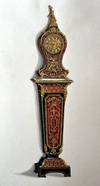

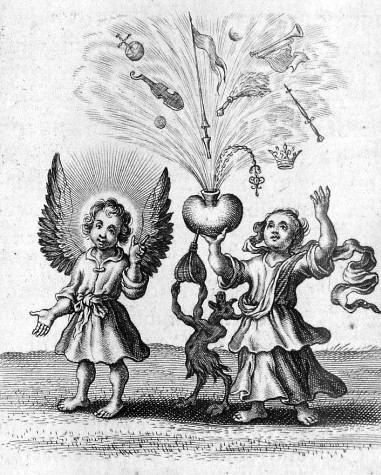
![[Incipit:] A la muy Esclarecida Señora, mi Señora la Señora, Doña Isabel Salzedo Azcona, Rio, &c. Condesa de Gomara, &c., dignissima esposa del Señor D. Manuel Villavicencio ... Marques de Alcantara, del Cuerbo, &c. Señora, aun no perfectamente deliberado a presidir este primero publico rasgo de mi corto ingenio in este Celeste Theatro de Salamanca …](https://d3525k1ryd2155.cloudfront.net/h/650/712/1676712650.0.m.jpg)
